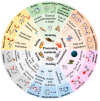Aroma Formation, Release, and Perception in Aquatic Products Processing: A Review
- PMID: 40807588
- PMCID: PMC12346763
- DOI: 10.3390/foods14152651
Aroma Formation, Release, and Perception in Aquatic Products Processing: A Review
Abstract
Flavor, as one of the primary factors that attracts consumers, has always been a crucial indicator for evaluating the quality of food. From processing to final consumption, the conditions that affect consumers' perception of the aroma of aquatic products can be divided into three stages: aroma formation, release, and signal transmission. Currently, there are few reviews on the formation, release, and perception of aroma in aquatic products, which has affected the product development of aquatic products. This review summarizes aroma formation pathways, the effects of processing methods, characteristic volatile compounds, various identification techniques, aroma-release influencing factors, and the aroma perception mechanisms of aquatic products. The Maillard reaction and lipid oxidation are the main pathways for the formation of aromas in aquatic products. The extraction, identification, and quantitative analysis of volatile compounds reveal the odor changes in aquatic products. The composition of aquatic products and oral processing mainly influence the release of odorants. The characteristic odorants perceived from the nasal cavity should be given more attention. Moreover, the relationship between various olfactory receptors (ORs) and the composition of multiple aromatic compounds remains to be understood. It is necessary to clarify the relationship between nasal cavity metabolism and odor perception, reveal the binding and activation mode of ORs and odor molecules, and establish an accurate aroma prediction model.
Keywords: aquatic products; aroma formation; aroma perception; odorants release.
Conflict of interest statement
The authors report no declarations of interest.
Figures
References
-
- FAO . Rome: Food and Agriculture Organization of the United Nations. FAO; Rome, Italy: 2016. The state of world fisheries and aquaculture.
-
- Cheng H., Wang J., Xie J. Progress on odor deterioration of aquatic products: Characteristic volatile compounds, analysis methods, and formation mechanisms. Food Biosci. 2023;53:102666. doi: 10.1016/j.fbio.2023.102666. - DOI
-
- Yu M., Yang P., Song H., Guan X. Research progress in comprehensive two-dimensional gas chromatography-mass spectrometry and its combination with olfactometry systems in the flavor analysis field. J. Food Compos. Anal. 2022;114:104790. doi: 10.1016/j.jfca.2022.104790. - DOI
Publication types
Grants and funding
LinkOut - more resources
Full Text Sources




